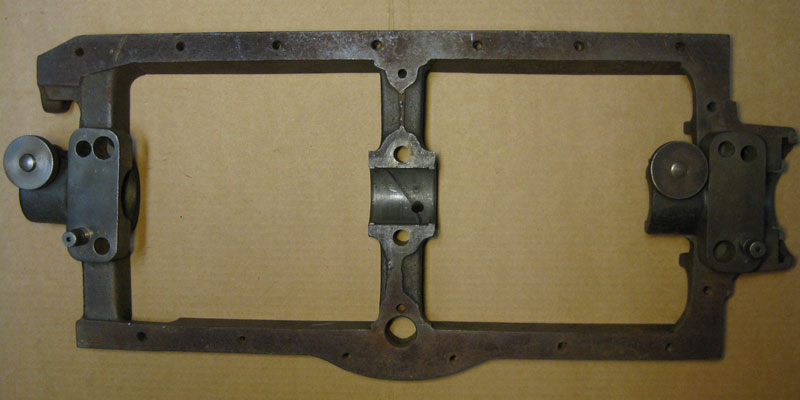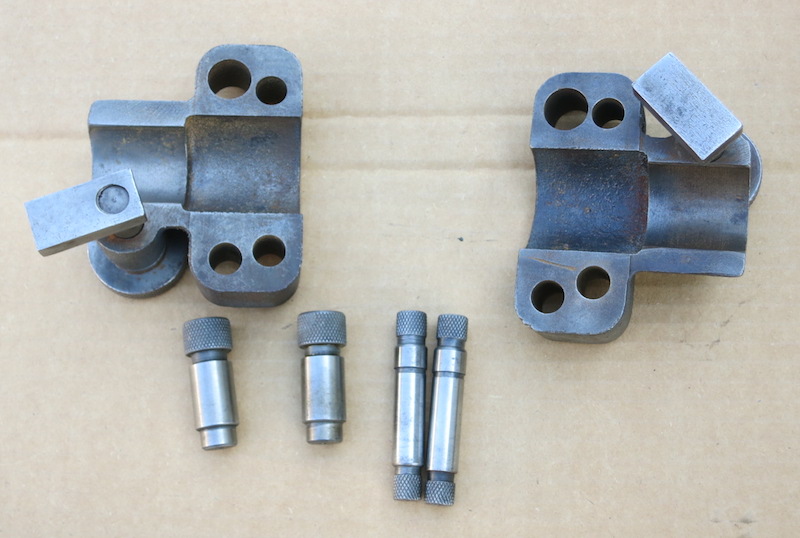Model A & B
Ford Garage
Kwik-Way LBM Boring Bar Locating Fixtures
Babbitt Main Bearing Align Boring

 fordgarage.com
fordgarage.comPictured above is a pair of Kwik-Way LBM main bearing align boring bar centering fixtures positioned on the bearing saddles in a pan rail section (for illustration) of a Model A engine block. These fixtures are used to properly locate the boring bar centerline for machining the poured Babbitt main bearings for the Model A and B crankshaft.

 fordgarage.com
fordgarage.com
 fordgarage.com
fordgarage.comThe fixtures have (near-net) locating pin holes for various Ford blocks including Model A, Model B, early flathead V8, and Fordson tractor. There is a front locating fixture and a rear fixture, which are similar but different.
The locating fixtures are used to precisely center the 1-1/4 inch diameter main bearing boring bar in the bearing saddles, and place the boring bar centerline at the pan rail datum plane.

 fordgarage.com
fordgarage.comPictured above is an illustration of Kwik-Way LBM boring bar flange feed nuts centered in a Model A engine block. These feed nuts are used to properly locate the boring bar cutter for machining the thrust faces of the poured Babbitt main bearing.
Also shown are the pan rail parallel bars on which the Kwik-Way LBM boring bar support bridges are mounted (bridges not shown).
- They position the bar to the block precisely in the cross-car and up/down positions at both the front and the rear of the block.
- They align the bar to the virtual design centerline of the crankshaft.
The Kwik-Way LBM bar locating fixtures can also be used to position the LEMPCO FSU boring frame on a block, instead of using the LEMPCO camshaft bore locators.
Both Kwik-Way and LEMPCO use a 1-1/4 inch diameter boring bar.

 fordgarage.com
fordgarage.comShown above is the boring bar rear locating fixture positioned in place and pin-located to the main bearing cap bolt hole.

 fordgarage.com
fordgarage.comShown above is the boring bar front locating fixture positioned in place and pin-located to the main bearing cap bolt hole.
The Kwik-Way LBM boring bar locating fixtures rely on the integrity of the block pan rail datum surfaces, and utilize the positions of the block main bearing bolt holes.
The Kwik-Way LBM boring bar locating fixtures do not 'know' or account for the location of the camshaft directly, or make use of the camshaft bores, or utilize a false cam for alignment to the block.


The scan above is from the Ford block drawing, showing the datum hole at the rear bearing saddle. The corresponding hole at the front bearing saddle is also designated as a datum for block machining.
The concept of locating the main bearing boring bar independent of the camshaft centerline position is a bit counterintuitive in a non-timing chain engine like a Model A.
However, Ford did originally use the main bearing bolt holes as the net datum features for all subsequent critical block machining operations as shown above, and Kwik-Way follows the original production philosophy.
The bar locating fixtures are removed after the Kwik-Way LBM bar bearings and support bridges have been fastened in place, and the engine bearing caps are then bolted to the block for subsequent align boring of the cast Babbitt.

 fordgarage.com
fordgarage.comThe main bearing boring bar is supported during Babbitt boring by the adjustable Kwik-Way LBM bar bearings and support bridges placed on the parallel bars, as shown above on a flathead V8 block.


The boring bar itself can also be located using the Kwik-Way LBM fixtures, but supported for boring by the specifically designed LEMPCO FSU cast iron boring frame for a Model A/B block.
This is an alternative to using the universally adaptable Kwik-Way LBM parallel bars, bar bearings, and support bridges. The LEMPCO frame assures a faster and more repeatable set up.
Visit the links below on Ford Garage for more information about establishing and maintaining proper crankshaft and camshaft timing gear engagement and clearances.
Check your measurements before cutting!
More related information on Ford Garage:
- For more Model A & B related information, use the Site Search box at the top or bottom of this page.
- Model A & B Camshaft to Crankshaft Gear Alignment
- Model A & B Proper Crankshaft and Camshaft Positioning
- Model A & B Rear Main Bearing Caps
- Model A & B Tobin-Arp Main Bearing Boring Bar Fixtures
- Model A & B LEMPCO FSU Main Bearing Line Boring Machine
- Kwik-Way LBM Line Boring Machine Operating Instructions
- Kwik-Way LBM Line Boring Machine Parts List
- Model A & B AER Insert Main Bearing Data & Instructions
Vince Falter
December 2009

